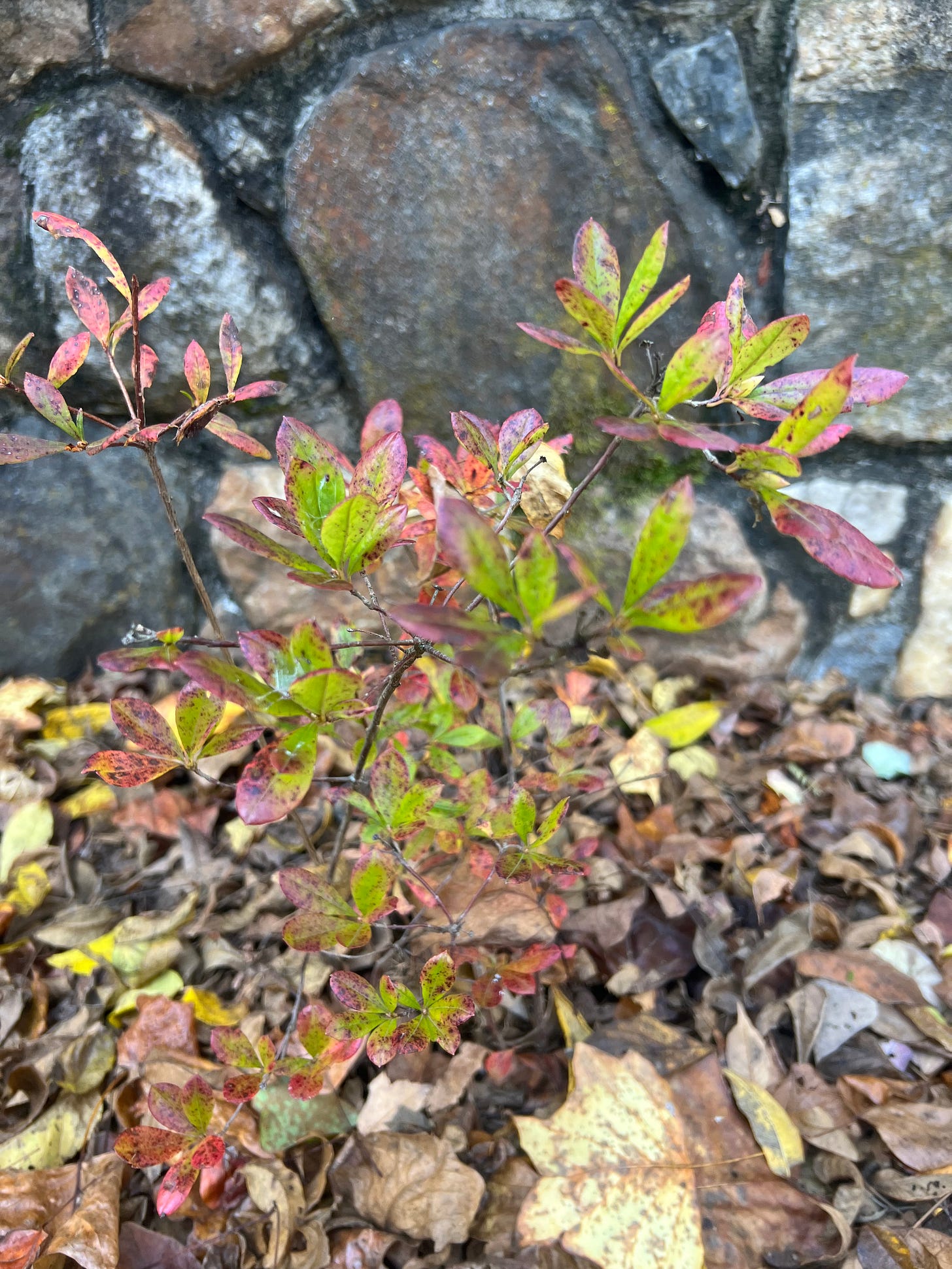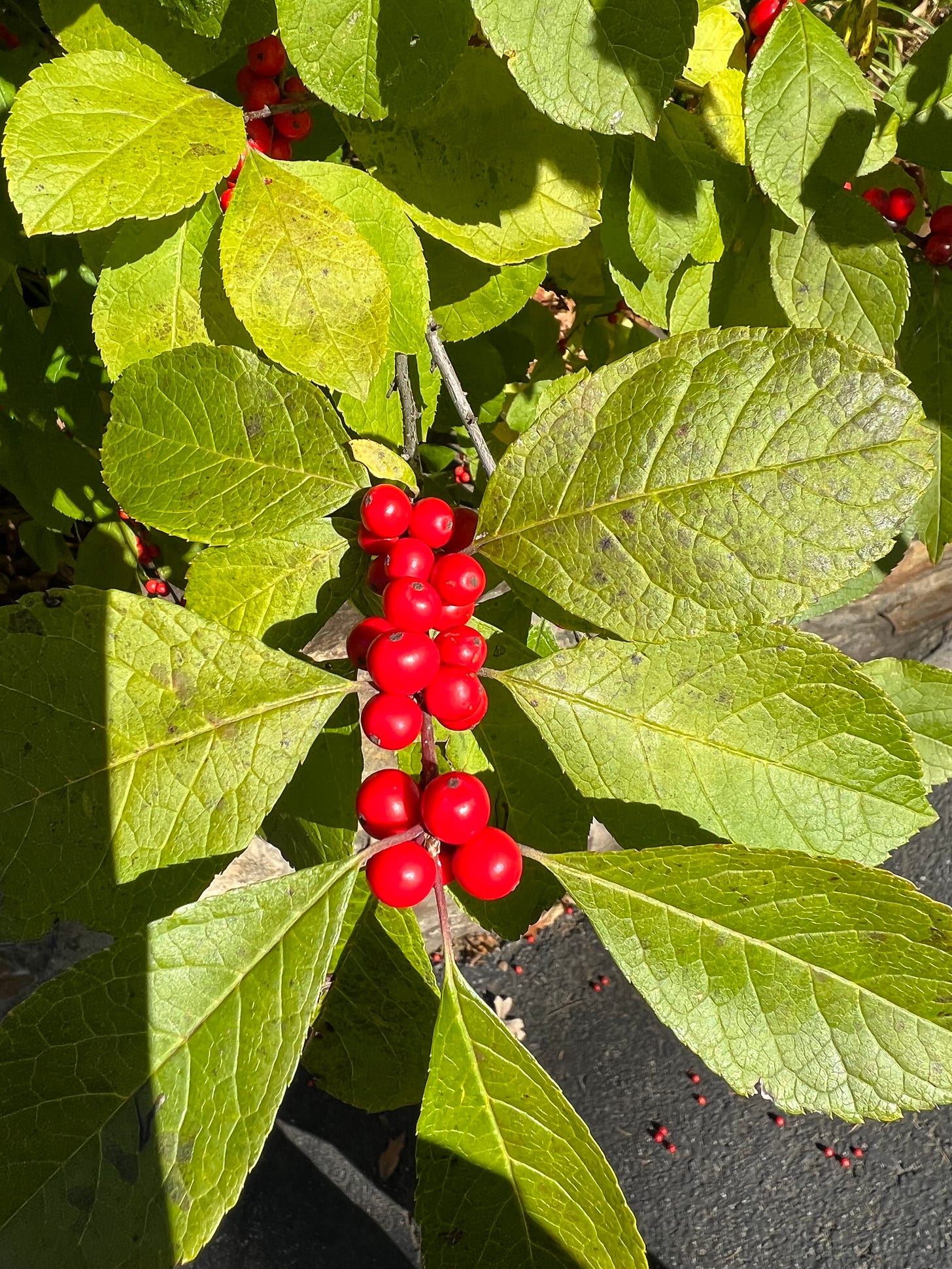Mice vs. Mouse
Puddock Hill Journal #28: Collective slaughter comes easier than killing a single mouse.
We had our first frost warning of the season last night. Pam raced to cut the dahlias, resulting in lavish flower harvesting:
But the frost didn’t quite reach us, and there are no more warnings in the ten-day forecast. We’ll see what November brings.
As climate change progresses and we experience more of it directly, we tend to focus on the high temperatures of summer, but it’s the higher lows of winter that are most alarming to scientists. In short, the seasons are flattening in temperate climates, and a future without the winter bite to which native species of plant and animal are adapted may result in many unhappy consequences.
Yet, fall still arrives, and with it a familiar pattern of seasonal change. The days grow shorter as they always will, no matter how high atmospheric greenhouse gases climb. The deciduous trees and shrubs go bare. Berries stand out. Many birds depart, while other critters die or hibernate.
One of the more unpleasant chores of autumn is setting mousetraps inside the house. Unpleasant because it brings intimacy to the killing we do, turns all of us softies into hunters in ways we can’t deny.
I am not opposed to responsible hunting. I have eaten my share of venison, goose, duck, and fish harvested from the wild, even put a few pellets in birds on the fly, although I do look back on that brief time and wonder who I was kidding, who I was trying to be. I simply don’t grok with the mentality of the hunt, although I fully admit to the necessity of hunting at times, if not the notion of calling it sport.
But let’s face it, killing for our own comfort is a small step away from killing for our own enjoyment. The distinctions may be subtle, but from the victim’s perspective the outcome remains the same.
Setting kill traps for mice is hunting out of perceived necessity. Cued by the changes of autumn, the mice seek warmth in our houses every year and we slaughter them because we can’t, and probably shouldn’t, countenance the damage that they do or the trails of poop that they leave. You only need to find mouse poop in the pantry once or twice to embrace the proposition that this behavior won’t stand.
Yet, I find it far easier to hate the vermin collectively than to remove an individual mouse. What gets me more than anything is when you turn them over on their way to the trash and see their genitals. Suddenly the “it” becomes a “he” or “she.” Small step from there to bestowing a name upon the poor creature.
And that’s the challenge, isn’t it? We collectively detest the brazen Canada geese that make a mess of things and add harmful phosphorous to the pond, but I’ll never bring myself to wring one’s neck. The deer are a menace to native plants, but I can’t look one in the eye and murder it. If a mouse ran across the floor right now, I would be hard pressed to stomp it to death with my boot.
In fact, when one of our traps once caught a live mouse by the tail, I carried it outside and set the critter free. That only seemed fair, but no doubt he anonymously returned to the house and died a quick death at another hour. Because they usually kill immediately, we only use spring-loaded mouse traps. Glue traps are unnecessarily cruel, and poisons aren’t much better. So-called humane mouse traps only prolong the battle, as the mice will return over and over until we forget to check the traps often enough and they starve to death.
As I had been last week, I am currently reading The Insect Crisis: The Fall of the Tiny Empires That Run the World by Oliver Milman, and I continue to reflect on it. One thing it reminds me of is how we occlude all the killing we do, out of sight too often meaning out of mind.
Most of the insecticides we apply are not specific to one type of insect pest, and even those said to be more targeted rarely avoid collateral damage to other players in the web of life. Herbicides, too, can have unintended consequences on wildlife, including birds.
A recent Finnish study found that even small amounts of Roundup weed killer impaired the ability of bumblebees to distinguish and “memorize connections between colors and taste,” thereby negatively impacting “foraging and nesting success” and increasing mortality, according to an article in Phys.org. What if you went out into the garden with your bottle of Roundup and met a bumblebee, observed it, discovered its gender, gave it a name? Might that deter you from spraying the chemical, knowing it might harm that individual? But of course that never happens. We go blithely on with our killing.
In 1942, Virginia Woolf’s famous essay “The Death of the Moth” was published. In it she reflected on a single moth trapped inside the window as it struggled for its last measure of life. Woolf didn’t bestow a name upon the moth, and one might easily argue, as many have, that the insect’s last gasp was a metaphor for human struggle. Still: the moth, the struggle.
Woolf’s essay was published posthumously a year after she wrote it. She died by suicide.
A fall walk along the driveway reveals berries on American holly (Ilex opaca):
Fall color on native Swamp azalea (Rhododendron viscosum) before leaf drop:
Fallen native black walnut (Juglans nigra) fruit:
Winterberry (Ilex verticillata):








While we use mouse traps in the basement, my wife sets small cotton balls with drops of peppermint essential oils in the kitchen. This has proved to be a wonderful deterrent in the upstairs
The peppermint is a nice idea, also said to deter ants, although we've had mixed results on that. I'll give the cottontails a try. At least it will confine the slaughter to the attic and basement, perhaps.